In the endgame to a struggle that has spanned some three decades, Air Force special operations forces are about to acquire the advantages conferred by a unique new aircraft—one that, in a sense, sprang up from the fiery, long-ago Desert One disaster in Iran.
Plans call for Air Force Special Operations Command early this year to declare operational the first squadron of CV-22 tilt-rotor aircraft. The Osprey is the SOF variant of a hybrid with the speed and range of fixed wing transport plus the landing capability of a helicopter.
Availability of such an aircraft on April 24, 1980 might have prevented Desert One. The plan to rescue American hostages in Iran was made overly complex and dangerous by the need to use short-legged helicopters. In a desert refueling stop, an RH-53 chopper struck a USAF C-130, causing a fire that killed eight servicemen.
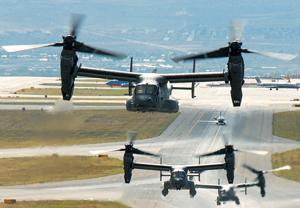 |
Three Ospreys take off at Kirtland AFB, N.M. (Civilian aircraft share airfield facilities.) |
The calamity gave impetus to a program to develop an aircraft possessing capabilities exceeding those of any standard helicopter. When the first CV-22 arrived at Kirtland AFB, N.M., March 20, 2006, Lt. Gen. Michael W. Wooley, then AFSOC commander, called it “truly transformational.”
What became the V-22 program originated in the late 1960s with a Marine Corps study of possible replacements for its Vietnam-vintage CH-46 and CH-53D medium-lift helicopters. The Pentagon then authorized a multiservice program in 1982, with the Marine Corps as lead.
Although the Army soon dropped out, the Navy and Air Force remained in the program. In 1983, the Marine Corps awarded a contract to a team of Bell and Boeing helicopter units to develop a tilt-rotor aircraft.
Air Force personnel have been involved in the Osprey program from the inception of the joint program. Air Force and Marine Corps colonels have alternated as the V-22 program manager.
Although the program has moved ahead relatively smoothly in recent years, delays and design changes early in the project drove the Marine Corps MV-22’s price from a projected cost of $24 million per aircraft in 1986 to an estimated $84 million today.
When US Special Operations Command-funded modifications and specialized equipment are added, the current cost for each CV-22 approaches $100 million. To perform extended-range missions into potentially well-defended areas, the CV-22 is equipped with terrain-following radar, sophisticated navigation systems, and a suite of integrated electronics. It is also equipped with infrared warning and countermeasures designed to ward off heat-seeking missiles.
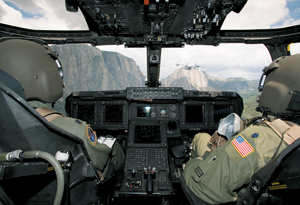 |
Lt. Col. Mike Duffy (l) and Lt. Col. James Breck maneuver the No. 2 CV-22A through the mountains of New Mexico on a training mission. |
Special Operations Command says the CV-22 will enable the command to do what it cannot do now, and what the military could not do in 1980: “Conduct long-range, high-speed, vertical lift missions in an aircraft capable of getting troops into and out of an area in one night.”
The Osprey’s range gives Special Operations Command a self-deploying capability it does not have with any helicopter. This will allow the Air Force’s air commandos to quickly take on faraway missions. The CV-22’s hover ability also means Special Operations Command will be able to insert, extract, or resupply special operations forces in rugged terrain inaccessible to fixed wing transports.
A Quiet Ride
The aircraft demonstrated that capability in November, when four CV-22s deployed from Hurlburt Field, Fla., to Africa for an exercise, going more than 5,000 miles nonstop with in-flight refueling.
“After that super long flight, we could have easily taken that aircraft out and put another 10 hours on it,” said TSgt. Aaron Brown, a flight engineer on one of those Ospreys. “We’re all pretty happy with the way it performed.”
Special Operations Command said the CV-22, in aircraft mode, is 75 percent quieter than rotary wing aircraft—a valuable attribute in SOF clandestine missions.
The marines have found in exercises that the Osprey’s speed and lower noise level allow the aircraft to get in to landing zones before a hostile force can react. Rapid acceleration after lift off and higher operating altitude allow the tilt-rotor to escape many of the automatic weapons and shoulder-mounted rockets so deadly to helicopters.
The 58th Special Operations Wing at Kirtland began CV-22 aircrew training with the first two production aircraft in August 2006. The first operational CV-22 was delivered to the 8th Special Operations Squadron at Hurlburt on Nov. 16, 2006.
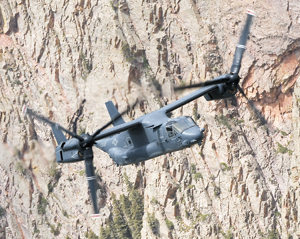 |
Airmen from the 71st Special Operations Squadron take the Osprey through its paces during a low-level training mission over central New Mexico. |
The Air Force was scheduled to have 10 CV-22s by the first of this year: six at Hurlburt and four at Kirtland.
Lt. Col. Darryl Sheets, Special Operations Command’s CV-22 branch chief of standardization and evaluation, said the 8th SOS is in the “stand-up phase,” which includes getting the processes, procedures, regulations, and publications written and amended for the CV-22.
The command also “continues to train crews as we look forward to [initial operational capability]. Everything has been focused on training, both unilaterally and in the joint environment with the typical SOF forces,” Sheets said.
The initial cadre of pilots and flight engineers were board-selected from a group of volunteers. The first four operational pilots included two with fixed wing experience and two from helicopters. The majority of a later group were experienced rotary wing pilots, he said. There were clearly helicopter crews available, as the Air Force retired its Vietnam-era MH-53s last year.
Currently, Osprey crew assignment follows the normal Air Force selection processes, “so we can get anyone from fixed wing or rotary wing,” Sheets said.
The 8th just received its first pilot straight from the training command, which Sheets said was necessary to keep the squadron from becoming too top-heavy with senior aviators.
By IOC, the 8th expected to have six aircraft and nine trained crews. The final number of CV-22s and crews is still being determined, he said.
After filling out the 8th at Hurlburt, Special Operations Command plans to create another CV-22 squadron at Cannon AFB, N.M., in 2010.
The CV-22 went through a rigorous initial operational test and evaluation process last summer. The final report is being drafted, and its findings will help determine if and when the 8th becomes an operational combat squadron.
After the test phase ended, Brig. Gen. Bradley A. Heithold, Special Operations Command’s planning director, said he was sure the CV-22 “has proven its capability.”
The Ospreys are demonstrating that they can operate in austere conditions.
Ten Marine Corps MV-22s have accumulated hundreds of hours in Iraq, ferrying troops and equipment into forward operating bases and evacuating casualties with a speed and range unmatched by the helicopters they replaced. One even transported then-Sen. Barack Obama during his visit to Iraq last summer.
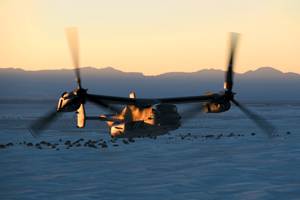 |
An Osprey navigates over the White Sands Monument in New Mexico. The state’s varied and rugged terrain is an ideal training ground for the special operations aircraft. |
Rugged Training
Special Operations Command deliberately exposed its CV-22s to challenging conditions. The four aircraft from Hurlburt operated in Mali for three weeks to support Operation Flintlock 09, a multinational exercise arranged by the new US Africa Command.
Capt. Randall Voas, a CV-22 aircraft commander, said self-deploying those aircraft—not having to load them on a ship or into a C-17—”was really a watershed moment.”
Voas said the normal mission was to fly local troops and Army Special Forces trainers, 500 to 550 miles one way “to an LZ in the dust,” and bring them back later. That took about five hours of total flight time, a fraction of what a helicopter would require. “It gives them a lot more time on the ground to affect the operations they have to affect.”
The CV-22 has a cruise speed of 277 miles per hour, and a range of more than 970 miles with normal fuel load (more than 2,400 miles with auxiliary fuel tanks). It can carry 24 troops in shock-absorbing seats—or 32 sitting on the floor—or 10,000 pounds of cargo. It has a normal crew of two pilots and two enlisted flight engineers.
As for aircraft reliability, “we had no mission aborts,” Voas said. “Every mission tasking we had, we satisfied.”
Lt. Col. Eric Hill, commander of the 8th SOS, called the deployment “an awesome event.”
It is a Special Operations Command decision when to declare the CV-22 operational, Hill said, but “from a squadron commander’s perspective, … the 8th SOS is ready for anything, whenever we’re called.”
The Osprey had to rise several times to get this far. Secretary of Defense Dick Cheney tried to cancel it in 1989, but Congress kept the program alive. The Marine Corps bore most of the costs through two painful decades of development and testing. Thirty marines and Boeing personnel died in four crashes during the prolonged development of the Osprey, which consumed an estimated $22 billion.
The aircraft and its program were significantly restructured after two deadly crashes in 2000 again brought the V-22 to the brink of cancellation.
The tilt-rotor concept had been conceived as early as the 1940s, and several experimental models were built, including the XV-15, which Bell produced for NASA in 1977.
The Bell-Boeing proposal was for an aircraft with two jet engines, which powered large rotor blades, on the end of short wings. The rotors moved from a horizontal position overhead, allowing the aircraft to operate like a helicopter, to a vertical setting, turning it into a turboprop airplane able to fly about twice as fast, three times as far, and much higher than any helicopter.
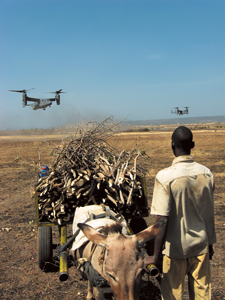 |
A Malian local watches incoming USAF Ospreys carrying Malian and Senegalese troops during a training mission in Mali. (USAF photo by Capt. Bryan Purtell) |
Going, Going … But Not Gone
The V-22 prototype flew for the first time in March 1989, but became an easy target for critics in Congress and elsewhere as it suffered through manufacturing defects, design flaws, cost growth, and poor testing.
Notable was its failure to conduct a full range of flight tests needed to determine the response to a flight condition called vortex ring state (VRS), common to all rotary wing aircraft. VRS, which occurs when a rotary wing aircraft descends too quickly with too little forward speed—so the rotors lose lift—caused a crash in April 2000 that killed 19 marines.
After another fatal crash that December, Pentagon officials grounded the Ospreys, and the program appeared doomed.
But because the capabilities the V-22 offers are so great, and on the advice of a blue-ribbon commission of aviation experts, defense officials gave the Osprey one more chance. While the contractors began to substantially modify the Osprey’s complex flight control systems and computer software programs, V-22s were subjected to a series of increasingly challenging flight tests.
Eighteen months later, those tests had demonstrated that the tilt-rotor is actually less susceptible to VRS than conventional helicopters and, due to the movable rotors, recovers faster. The redesigned aircraft also provides visual and oral VRS warnings.
Although no expensive defense procurement program is ever safe, the Osprey’s future appears to be relatively secure.
The Pentagon signed a $10.4 billion multiyear agreement with Bell and Boeing last year to buy 167 V-22s through 2012.
The current Air Force plan is to purchase 50 CV-22s by 2017. Of the 50 planned aircraft, 44 are to go into operational squadrons and six to the training squadron at Kirtland. Lt. Gen. Donald C. Wurster, head of Air Force Special Operations Command, has said that the requirement will almost certainly grow because of the planned increases in SOCOM.
Wurster said he also would like to accelerate the rate of CV-22 purchases—which has been five or six aircraft a year—partly because Special Operations Command’s MH-53 Pave Lows are gone.
The CV-22 is “not a Pave Low replacement,” Sheets added. “It’s just an additional capability for SOF, and Special Operations Command, to stretch our legs a bit farther and increase our range and capability.”
The best way to think about the Osprey, he said, is as “an augmentation for everything we’ve ever had in SOF. It’s an augmentation for rotary wing, and also gives the combatant commanders an additional way to execute their missions, possibly have one aircraft do a mission that previously required two aircraft to complete.”
